A Discriminatively Trained, Multiscale, Deformable Part Model
Pedro Felzenszwalb
University of Chicago
pff@cs.uchicago.edu
Abstract
David McAllester
Toyota Technological Institute at Chicago
mcallester@tti-c.org
Deva Ramanan
TTI-C and UC Irvine
dramanan@ics.uci.edu
This paper describes a discriminatively trained, multi-
scale, deformable part model for object detection. Our sys-
tem achieves a two-fold improvement in average precision
over the best performance in the 2006 PASCAL person de-
tection challenge. It also outperforms the best results in the
2007 challenge in ten out of twenty categories. The system
relies heavily on deformable parts. While deformable part
models have become quite popular, their value had not been
demonstrated on difficult benchmarks such as the PASCAL
challenge. Our system also relies heavily on new methods
for discriminative training. We combine a margin-sensitive
approach for data mining hard negative examples with a
formalism we call latent SVM. A latent SVM, like a hid-
den CRF, leads to a non-convex training problem. How-
ever, a latent SVM is semi-convex and the training prob-
lem becomes convex once latent information is specified for
the positive examples. We believe that our training meth-
ods will eventually make possible the effective use of more
latent information such as hierarchical (grammar) models
and models involving latent three dimensional pose.
1. Introduction
We consider the problem of detecting and localizing ob-
jects of a generic category, such as people or cars, in static
images. We have developed a new multiscale deformable
part model for solving this problem. The models are trained
using a discriminative procedure that only requires bound-
ing box labels for the positive examples. Using these mod-
els we implemented a detection system that is both highly
efficient and accurate, processing an image in about 2 sec-
onds and achieving recognition rates that are significantly
better than previous systems.
Our system achieves a two-fold improvement in average
precision over the winning system [5] in the 2006 PASCAL
person detection challenge. The system also outperforms
the best results in the 2007 challenge in ten out of twenty
object categories. Figure 1 shows an example detection ob-
tained with our person model.
Figure 1. Example detection obtained with the person model. The
model is defined by a coarse template, several higher resolution
part templates and a spatial model for the location of each part.
The notion that objects can be modeled by parts in a de-
formable configuration provides an elegant framework for
representing object categories [1–3,6,10,12,13,15,16,22].
While these models are appealing from a conceptual point
of view, it has been difficult to establish their value in prac-
tice. On difficult datasets, deformable models are often out-
performed by “conceptually weaker” models such as rigid
templates [5] or bag-of-features [23]. One of our main goals
is to address this performance gap.
Our models include both a coarse global template cov-
ering an entire object and higher resolution part templates.
The templates represent histogram of gradient features [5].
As in [14, 19, 21], we train models discriminatively. How-
ever, our system is semi-supervised, trained with a max-
margin framework, and does not rely on feature detection.
We also describe a simple and effective strategy for learn-
ing parts from weakly-labeled data. In contrast to computa-
tionally demanding approaches such as [4], we can learn a
model in 3 hours on a single CPU.
Another contribution of our work is a new methodology
for discriminative training. We generalize SVMs for han-
dling latent variables such as part positions, and introduce a
new method for data mining “hard negative” examples dur-
ing training. We believe that handling partially labeled data
is a significant issue in machine learning for computer vi-
sion. For example, the PASCAL dataset only specifies a
bounding box for each positive example of an object. We
treat the position of each object part as a latent variable. We
1
�
also treat the exact location of the object as a latent vari-
able, requiring only that our classifier select a window that
has large overlap with the labeled bounding box.
A latent SVM, like a hidden CRF [19], leads to a non-
convex training problem. However, unlike a hidden CRF,
a latent SVM is semi-convex and the training problem be-
comes convex once latent information is specified for the
positive training examples. This leads to a general coordi-
nate descent algorithm for latent SVMs.
System Overview Our system uses a scanning window
approach. A model for an object consists of a global “root”
filter and several part models. Each part model specifies a
spatial model and a part filter. The spatial model defines a
set of allowed placements for a part relative to a detection
window, and a deformation cost for each placement.
The score of a detection window is the score of the root
filter on the window plus the sum over parts, of the maxi-
mum over placements of that part, of the part filter score on
the resulting subwindow minus the deformation cost. This
is similar to classical part-based models [10, 13]. Both root
and part filters are scored by computing the dot product be-
tween a set of weights and histogram of gradient (HOG)
features within a window. The root filter is equivalent to a
Dalal-Triggs model [5]. The features for the part filters are
computed at twice the spatial resolution of the root filter.
Our model is defined at a fixed scale, and we detect objects
by searching over an image pyramid.
In training we are given a set of images annotated with
bounding boxes around each instance of an object. We re-
duce the detection problem to a binary classification prob-
lem. Each example x is scored by a function of the form,
fβ(x) = maxz β · Φ(x, z). Here β is a vector of model pa-
rameters and z are latent values (e.g. the part placements).
To learn a model we define a generalization of SVMs that
we call latent variable SVM (LSVM). An important prop-
erty of LSVMs is that the training problem becomes convex
if we fix the latent values for positive examples. This can
be used in a coordinate descent algorithm.
In practice we iteratively apply classical SVM training to
triples (!x1, z1, y1", . . ., !xn, zn, yn") where zi is selected
to be the best scoring latent label for xi under the model
learned in the previous iteration. An initial root filter is
generated from the bounding boxes in the PASCAL dataset.
The parts are initialized from this root filter.
2. Model
The underlying building blocks for our models are the
Histogram of Oriented Gradient (HOG) features from [5].
We represent HOG features at two different scales. Coarse
features are captured by a rigid template covering an entire
detection window. Finer scale features are captured by part
2
Image pyramid
HOG feature pyramid
Figure 2. The HOG feature pyramid and an object hypothesis de-
fined in terms of a placement of the root filter (near the top of the
pyramid) and the part filters (near the bottom of the pyramid).
templates that can be moved with respect to the detection
window. The spatial model for the part locations is equiv-
alent to a star graph or 1-fan [3] where the coarse template
serves as a reference position.
2.1. HOG Representation
We follow the construction in [5] to define a dense repre-
sentation of an image at a particular resolution. The image
is first divided into 8x8 non-overlapping pixel regions, or
cells. For each cell we accumulate a 1D histogram of gra-
dient orientations over pixels in that cell. These histograms
capture local shape properties but are also somewhat invari-
ant to small deformations.
The gradient at each pixel is discretized into one of nine
orientation bins, and each pixel “votes” for the orientation
of its gradient, with a strength that depends on the gradient
magnitude at that pixel. For color images, we compute the
gradient of each color channel and pick the channel with
highest gradient magnitude at each pixel. Finally, the his-
togram of each cell is normalized with respect to the gra-
dient energy in a neighborhood around it. We look at the
four 2 × 2 blocks of cells that contain a particular cell and
normalize the histogram of the given cell with respect to the
total energy in each of these blocks. This leads to a 9 × 4
dimensional vector representing the local gradient informa-
tion inside a cell.
We define a HOG feature pyramid by computing HOG
features of each level of a standard image pyramid (see Fig-
ure 2). Features at the top of this pyramid capture coarse
gradients histogrammed over fairly large areas of the input
image while features at the bottom of the pyramid capture
finer gradients histogrammed over small areas.
�
2.2. Filters
of each part relative to the root (the spatial term),
Filters are rectangular templates specifying weights for
subwindows of a HOG pyramid. A w by h filter F is a
vector with w × h × 9 × 4 weights. The score of a filter is
defined by taking the dot product of the weight vector and
the features in a w × h subwindow of a HOG pyramid.
The system in [5] uses a single filter to define an object
model. That system detects objects from a particular class
by scoring every w × h subwindow of a HOG pyramid and
thresholding the scores.
Let H be a HOG pyramid and p = (x, y, l) be a cell in
the l-th level of the pyramid. Let φ(H, p, w, h) denote the
vector obtained by concatenating the HOG features in the
w × h subwindow of H with top-left corner at p. The score
of F on this detection window is F · φ(H, p, w, h).
Below we use φ(H, p) to denote φ(H, p, w, h) when the
dimensions are clear from context.
2.3. Deformable Parts
Here we consider models defined by a coarse root filter
that covers the entire object and higher resolution part filters
covering smaller parts of the object. Figure 2 illustrates a
placement of such a model in a HOG pyramid. The root fil-
ter location defines the detection window (the pixels inside
the cells covered by the filter). The part filters are placed
several levels down in the pyramid, so the HOG cells at that
level have half the size of cells in the root filter level.
We have found that using higher resolution features for
defining part filters is essential for obtaining high recogni-
tion performance. With this approach the part filters repre-
sent finer resolution edges that are localized to greater ac-
curacy when compared to the edges represented in the root
filter. For example, consider building a model for a face.
The root filter could capture coarse resolution edges such as
the face boundary while the part filters could capture details
such as eyes, nose and mouth.
The model for an object with n parts is formally defined
by a root filter F0 and a set of part models (P1, . . . , Pn)
where Pi = (Fi, vi, si, ai, bi). Here Fi is a filter for the i-th
part, vi is a two-dimensional vector specifying the center for
a box of possible positions for part i relative to the root po-
sition, si gives the size of this box, while ai and bi are two-
dimensional vectors specifying coefficients of a quadratic
function measuring a score for each possible placement of
the i-th part. Figure 1 illustrates a person model.
A placement of a model in a HOG pyramid is given by
z = (p0, . . . , pn), where pi = (xi, yi, li) is the location of
the root filter when i = 0 and the location of the i-th part
when i > 0. We assume the level of each part is such that a
HOG cell at that level has half the size of a HOG cell at the
root level. The score of a placement is given by the scores
of each filter (the data term) plus a score of the placement
(1)
i , ˜y2
i ),
n!i=1
Fi · φ(H, pi) +
ai · (˜xi, ˜yi) + bi · (˜x2
n!i=0
where (˜xi, ˜yi) = ((xi, yi) − 2(x, y) + vi)/si gives the lo-
cation of the i-th part relative to the root location. Both ˜xi
and ˜yi should be between −1 and 1.
There is a large (exponential) number of placements for
a model in a HOG pyramid. We use dynamic programming
and distance transforms techniques [9, 10] to compute the
best location for the parts of a model as a function of the
root location. This takes O(nk) time, where n is the number
of parts in the model and k is the number of cells in the
HOG pyramid. To detect objects in an image we score root
locations according to the best possible placement of the
parts and threshold this score.
The score of a placement z can be expressed in terms
of the dot product, β · ψ(H, z), between a vector of model
parameters β and a vector ψ(H, z),
β = (F0, . . . , Fn, a1, b1 . . . , an, bn).
ψ(H, z) = (φ(H, p0),φ (H, p1), . . . φ(H, pn),
n, ˜y2
1, . . . , ˜xn, ˜yn, ˜x2
˜x1, ˜y1, ˜x2
1, ˜y2
n, ).
We use this representation for learning the model parame-
ters as it makes a connection between our deformable mod-
els and linear classifiers.
On interesting aspect of the spatial models defined here
is that we allow for the coefficients (ai, bi) to be negative.
This is more general than the quadratic “spring” cost that
has been used in previous work.
3. Learning
The PASCAL training data consists of a large set of im-
ages with bounding boxes around each instance of an ob-
ject. We reduce the problem of learning a deformable part
model with this data to a binary classification problem. Let
D = (!x1, y1", . . . , !xn, yn") be a set of labeled exam-
ples where yi ∈ {−1, 1} and xi specifies a HOG pyramid,
H(xi), together with a range, Z(xi), of valid placements
for the root and part filters. We construct a positive exam-
ple from each bounding box in the training set. For these ex-
amples we define Z(xi) so the root filter must be placed to
overlap the bounding box by at least 50%. Negative exam-
ples come from images that do not contain the target object.
Each placement of the root filter in such an image yields a
negative training example.
Note that for the positive examples we treat both the part
locations and the exact location of the root filter as latent
variables. We have found that allowing uncertainty in the
root location during training significantly improves the per-
formance of the system (see Section 4).
3
�
3.1. Latent SVMs
A latent SVM is defined as follows. We assume that each
example x is scored by a function of the form,
fβ(x) = max
z∈Z(x)
β · Φ(x, z),
(2)
where β is a vector of model parameters and z is a set
of latent values. For our deformable models we define
Φ(x, z) = ψ(H(x), z) so that β · Φ(x, z) is the score of
placing the model according to z.
In analogy to classical SVMs we would like to train β
from labeled examples D = (!x1, y1", . . . , !xn, yn") by
optimizing the following objective function,
n!i=1
β
λ||β||2 +
β∗(D) = argmin
max(0, 1− yifβ(xi)). (3)
By restricting the latent domains Z(xi) to a single choice,
fβ becomes linear in β, and we obtain linear SVMs as a
special case of latent SVMs. Latent SVMs are instances of
the general class of energy-based models [18].
3.2. Semi-Convexity
Note that fβ(x) as defined in (2) is a maximum of func-
tions each of which is linear in β. Hence fβ(x) is convex
in β. This implies that the hinge loss max(0, 1 − yifβ(xi))
is convex in β when yi = −1. That is, the loss function is
convex in β for negative examples. We call this property of
the loss function semi-convexity.
Consider an LSVM where the latent domains Z(xi) for
the positive examples are restricted to a single choice. The
loss due to each positive example is now convex. Combined
with the semi-convexity property, (3) becomes convex in β.
If the labels for the positive examples are not fixed we
can compute a local optimum of (3) using a coordinate de-
scent algorithm:
1. Holding β fixed, optimize the latent values for the pos-
itive examples zi = argmaxz∈Z(xi) β · Φ(x, z).
2. Holding {zi} fixed for positive examples, optimize β
by solving the convex problem defined above.
It can be shown that both steps always improve or maintain
the value of the objective function in (3). If both steps main-
tain the value we have a strong local optimum of (3), in the
sense that Step 1 searches over an exponentially large space
of latent labels for positive examples while Step 2 simulta-
neously searches over weight vectors and an exponentially
large space of latent labels for negative examples.
3.3. Data Mining Hard Negatives
In object detection the vast majority of training exam-
ples are negative. This makes it infeasible to consider all
4
negative examples at a time. Instead, it is common to con-
struct training data consisting of the positive instances and
“hard negative” instances, where the hard negatives are data
mined from the very large set of possible negative examples.
Here we describe a general method for data mining ex-
amples for SVMs and latent SVMs. The method iteratively
solves subproblems using only hard instances. The innova-
tion of our approach is a theoretical guarantee that it leads
to the exact solution of the training problem defined using
the complete training set. Our results require the use of a
margin-sensitive definition of hard examples.
The results described here apply both to classical SVMs
and to the problem defined by Step 2 of the coordinate de-
scent algorithm for latent SVMs. We omit the proofs of the
theorems due to lack of space. These results are related to
working set methods [17].
We define the hard instances of D relative to β as,
M(β, D) = {!x, y" ∈ D | yfβ(x) ≤ 1}.
(4)
That is, M(β, D) are training examples that are incorrectly
classified or near the margin of the classifier defined by β.
We can show that β∗(D) only depends on hard instances.
Theorem 1. Let C be a subset of the examples in D. If
M(β∗(D), D) ⊆ C then β∗(C) = β∗(D).
This implies that in principle we could train a model us-
ing a small set of examples. However, this set is defined in
terms of the optimal model β∗(D).
Given a fixed β we can use M(β, D) to approximate
M(β∗(D), D). This suggests an iterative algorithm where
we repeatedly compute a model from the hard instances de-
fined by the model from the last iteration. This is further
justified by the following fixed-point theorem.
Theorem 2. If β∗(M(β, D)) = β then β = β∗(D).
Let C be an initial “cache” of examples. In practice we
can take the positive examples together with random nega-
tive examples. Consider the following iterative algorithm:
1. Let β := β∗(C).
2. Shrink C by letting C := M(β, C).
3. Grow C by adding examples from M(β, D) up to a
memory limit L.
Theorem 3. If |C| < L after each iteration of Step 2, the
algorithm will converge to β = β∗(D) in finite time.
3.4. Implementation details
Many of the ideas discussed here are only approximately
implemented in our current system. In practice, when train-
ing a latent SVM we iteratively apply classical SVM train-
ing to triples !x1, z1, y1", . . ., !xn, zn, yn" where zi is se-
lected to be the best scoring latent label for xi under the
�
model trained in the previous iteration. Each of these triples
leads to an example !Φ(xi, zi), yi" for training a linear clas-
sifier. This allows us to use a highly optimized SVM pack-
age (SVMLight [17]). On a single CPU, the entire training
process takes 3 to 4 hours per object class in the PASCAL
datasets, including initialization of the parts.
Root Filter Initialization: For each category, we auto-
matically select the dimensions of the root filter by looking
at statistics of the bounding boxes in the training data.1 We
train an initial root filter F0 using an SVM with no latent
variables. The positive examples are constructed from the
unoccluded training examples (as labeled in the PASCAL
data). These examples are anisotropically scaled to the size
and aspect ratio of the filter. We use random subwindows
from negative images to generate negative examples.
Root Filter Update: Given the initial root filter trained
as above, for each bounding box in the training set we find
the best-scoring placement for the filter that significantly
overlaps with the bounding box. We do this using the orig-
inal, un-scaled images. We retrain F0 with the new positive
set and the original random negative set, iterating twice.
Part Initialization: We employ a simple heuristic to ini-
tialize six parts from the root filter trained above. First, we
select an area a such that 6a equals 80% of the area of the
root filter. We greedily select the rectangular region of area
a from the root filter that has the most positive energy. We
zero out the weights in this region and repeat until six parts
are selected. The part filters are initialized from the root fil-
ter values in the subwindow selected for the part, but filled
in to handle the higher spatial resolution of the part. The
initial deformation costs measure the squared norm of a dis-
placement with ai = (0, 0) and bi = −(1, 1).
Model Update: To update a model we construct new
training data triples. For each positive bounding box in the
training data, we apply the existing detector at all positions
and scales with at least a 50% overlap with the given bound-
ing box. Among these we select the highest scoring place-
ment as the positive example corresponding to this training
bounding box (Figure 3). Negative examples are selected
by finding high scoring detections in images not containing
the target object. We add negative examples to a cache un-
til we encounter file size limits. A new model is trained by
running SVMLight on the positive and negative examples,
each labeled with part placements. We update the model 10
times using the cache scheme described above. In each it-
eration we keep the hard instances from the previous cache
and add as many new hard instances as possible within the
memory limit. Toward the final iterations, we are able to
include all hard instances, M(β, D), in the cache.
1We picked a simple heuristic by cross-validating over 5 object classes.
We set the model aspect to be the most common (mode) aspect in the data.
We set the model size to be the largest size not larger than 80% of the data.
5
Figure 3. The image on the left shows the optimization of the la-
tent variables for a positive example. The dotted box is the bound-
ing box label provided in the PASCAL training set. The large
solid box shows the placement of the detection window while the
smaller solid boxes show the placements of the parts. The image
on the right shows a hard-negative example.
4. Results
We evaluated our system using the PASCAL VOC 2006
and 2007 comp3 challenge datasets and protocol. We refer
to [7, 8] for details, but emphasize that both challenges are
widely acknowledged as difficult testbeds for object detec-
tion. Each dataset contains several thousand images of real-
world scenes. The datasets specify ground-truth bounding
boxes for several object classes, and a detection is consid-
ered correct when it overlaps more than 50% with a ground-
truth bounding box. One scores a system by the average
precision (AP) of its precision-recall curve across a testset.
Recent work in pedestrian detection has tended to report
detection rates versus false positives per window, measured
with cropped positive examples and negative images with-
out objects of interest. These scores are tied to the reso-
lution of the scanning window search and ignore effects of
non-maximum suppression, making it difficult to compare
different systems. We believe the PASCAL scoring method
gives a more reliable measure of performance.
The 2007 challenge has 20 object categories. We entered
a preliminary version of our system in the official competi-
tion, and obtained the best score in 6 categories. Our current
system obtains the highest score in 10 categories, and the
second highest score in 6 categories. Table 1 summarizes
the results.
Our system performs well on rigid objects such as cars
and sofas as well as highly deformable objects such as per-
sons and horses. We also note that our system is successful
when given a large or small amount of training data. There
are roughly 4700 positive training examples in the person
category but only 250 in the sofa category. Figure 4 shows
some of the models we learned. Figure 5 shows some ex-
ample detections.
We evaluated different components of our system on the
longer-established 2006 person dataset. The top AP score
�
bird
2
boat
1
bottle
1
bus
2
car
2
cat
4
bike
1
chair
1
tv
aero
3
1
.180 .411 .092 .098 .249 .349 .396 .110 .155 .165 .110 .062 .301 .337 .267 .140 .141 .156 .206 .336
Our rank
Our score
Darmstadt
.092 .246 .012 .002 .068 .197 .265 .018 .097 .039 .017 .016 .225 .153 .121 .093 .002 .102 .157 .242
INRIA Normal
.136 .287 .041 .025 .077 .279 .294 .132 .106 .127 .067 .071 .335 .249 .092 .072 .011 .092 .242 .275
INRIA Plus
.253
IRISA
MPI Center
.060 .110 .028 .031 .000 .164 .172 .208 .002 .044 .049 .141 .198 .170 .091 .004 .091 .034 .237 .051
MPI ESSOL .152 .157 .098 .016 .001 .186 .120 .240 .007 .061 .098 .162 .034 .208 .117 .002 .046 .147 .110 .054
.318 .026 .097 .119
cow table
1
1
horse mbike person plant
1
2
2
1
.289 .227 .221
sheep
2
train
4
sofa
1
dog
4
.175
.301
.281
Oxford
.262 .409
.393 .432
.375
.334
TKK .186 .078 .043 .072 .002 .116 .184 .050 .028 .100 .086 .126 .186 .135 .061 .019 .036 .058 .067 .090
Table 1. PASCAL VOC 2007 results. Average precision scores of our system and other systems that entered the competition [7]. Empty
boxes indicate that a method was not tested in the corresponding class. The best score in each class is shown in bold. Our current system
ranks first in 10 out of 20 classes. A preliminary version of our system ranked first in 6 classes in the official competition.
Sofa
Bicycle
Bottle
Car
Figure 4. Some models learned from the PASCAL VOC 2007 dataset. We show the total energy in each orientation of the HOG cells in
the root and part filters, with the part filters placed at the center of the allowable displacements. We also show the spatial model for each
part, where bright values represent “cheap” placements, and dark values represent “expensive” placements.
in the PASCAL competition was .16, obtained using a rigid
template model of HOG features [5]. The best previous re-
sult of .19 adds a segmentation-based verification step [20].
Figure 6 summarizes the performance of several models we
trained. Our root-only model is equivalent to the model
from [5] and it scores slightly higher at .18. Performance
jumps to .24 when the model is trained with a LSVM that
selects a latent position and scale for each positive example.
This suggests LSVMs are useful even for rigid templates
because they allow for self-adjustment of the detection win-
dow in the training examples. Adding deformable parts in-
creases performance to .34 AP — a factor of two above the
best previous score. Finally, we trained a model with parts
but no root filter and obtained .29 AP. This illustrates the
advantage of using a multiscale representation.
We also investigated the effect of the spatial model and
allowable deformations on the 2006 person dataset. Recall
that si is the allowable displacement of a part, measured in
HOG cells. We trained a rigid model with high-resolution
parts by setting si to 0. This model outperforms the root-
only system by .27 to .24.
If we increase the amount of
allowable displacements without using a deformation cost,
we start to approach a bag-of-features. Performance peaks
at si = 1, suggesting it is useful to constrain the part dis-
placements. The optimal strategy allows for larger displace-
ments while using an explicit deformation cost. The follow-
6
�
Figure5.SomeresultsfromthePASCAL2007dataset.Eachrowshowsdetectionsusingamodelforaspecificclass(Person,Bottle,Car,Sofa,Bicycle,Horse).Thefirstthreecolumnsshowcorrectdetectionswhilethelastcolumnshowsfalsepositives.Oursystemisabletodetectobjectsoverawiderangeofscales(suchasthecars)andposes(suchasthehorses).Thesystemcanalsodetectpartiallyoccludedobjectssuchasapersonbehindabush.Notehowthefalsedetectionsareoftenquitereasonable,forexampledetectingabuswiththecarmodel,abicyclesignwiththebicyclemodel,oradogwiththehorsemodel.Ingeneralthepartfiltersrepresentmeaningfulobjectpartsthatarewelllocalizedineachdetectionsuchastheheadinthepersonmodel.7�
i
i
n
o
s
c
e
r
p
1
0.9
0.8
0.7
0.6
0.5
0.4
0.3
0.2
0.1
0
0
PASCAL2006 Person
Root (0.18)
Root+Latent (0.24)
Parts+Latent (0.29)
Root+Parts+Latent (0.34)
0.1 0.2 0.3 0.4 0.5 0.6 0.7 0.8 0.9
recall
1
Figure 6. Evaluation of our system on the PASCAL VOC 2006
person dataset. Root uses only a root filter and no latent place-
ment of the detection windows on positive examples. Root+Latent
uses a root filter with latent placement of the detection windows.
Parts+Latent is a part-based system with latent detection windows
but no root filter. Root+Parts+Latent includes both root and part
filters, and latent placement of the detection windows.
ing table shows AP as a function of freely allowable defor-
mation in the first three columns. The last column gives the
performance when using a quadratic deformation cost and
an allowable displacement of 2 HOG cells.
si
AP
0
.27
1
.33
2
.31
3
.31
2 + quadratic cost
.34
5. Discussion
We introduced a general framework for training SVMs
with latent structure. We used it to build a recognition sys-
tem based on multiscale, deformable models. Experimental
results on difficult benchmark data suggests our system is
the current state-of-the-art in object detection.
LSVMs allow for exploration of additional latent struc-
ture for recognition. One can consider deeper part hierar-
chies (parts with parts), mixture models (frontal vs. side
cars), and three-dimensional pose. We would like to train
and detect multiple classes together using a shared vocab-
ulary of parts (perhaps visual words). We also plan to use
A* search [11] to efficiently search over latent parameters
during detection.
References
[1] Y. Amit and A. Trouve. POP: Patchwork of parts models for
object recognition. IJCV, 75(2):267–282, November 2007.
[2] M. Burl, M. Weber, and P. Perona. A probabilistic approach
to object recognition using local photometry and global ge-
ometry. In ECCV, pages II:628–641, 1998.
8
[3] D. Crandall, P. Felzenszwalb, and D. Huttenlocher. Spatial
priors for part-based recognition using statistical models. In
CVPR, pages 10–17, 2005.
[4] D. Crandall and D. Huttenlocher. Weakly supervised learn-
ing of part-based spatial models for visual object recognition.
In ECCV, pages I: 16–29, 2006.
[5] N. Dalal and B. Triggs. Histograms of oriented gradients for
human detection. In CVPR, pages I: 886–893, 2005.
[6] B. Epshtein and S. Ullman. Semantic hierarchies for recog-
nizing objects and parts. In CVPR, 2007.
[7] M. Everingham, L. Van Gool, C. K. I. Williams, J. Winn,
and A. Zisserman. The PASCAL Visual Object Classes
Challenge 2007 (VOC2007) Results.
http://www.pascal-
network.org/challenges/VOC/voc2007/workshop.
[8] M. Everingham, A. Zisserman, C. K. I. Williams, and
The PASCAL Visual Object Classes
http://www.pascal-
L. Van Gool.
Challenge 2006 (VOC2006) Results.
network.org/challenges/VOC/voc2006/results.pdf.
[9] P. Felzenszwalb and D. Huttenlocher. Distance transforms
of sampled functions. Cornell Computing and Information
Science Technical Report TR2004-1963, September 2004.
[10] P. Felzenszwalb and D. Huttenlocher. Pictorial structures for
object recognition. IJCV, 61(1), 2005.
[11] P. Felzenszwalb and D. McAllester. The generalized A* ar-
chitecture. JAIR, 29:153–190, 2007.
[12] R. Fergus, P. Perona, and A. Zisserman. Object class recog-
In CVPR,
nition by unsupervised scale-invariant learning.
2003.
[13] M. Fischler and R. Elschlager. The representation and
matching of pictorial structures. IEEE Transactions on Com-
puter, 22(1):67–92, January 1973.
[14] A. Holub and P. Perona. A discriminative framework for
modelling object classes. In CVPR, pages I: 664–671, 2005.
[15] S. Ioffe and D. Forsyth. Probabilistic methods for finding
people. IJCV, 43(1):45–68, June 2001.
[16] Y. Jin and S. Geman. Context and hierarchy in a probabilistic
image model. In CVPR, pages II: 2145–2152, 2006.
[17] T. Joachims. Making large-scale svm learning practical. In
B. Sch¨olkopf, C. Burges, and A. Smola, editors, Advances in
Kernel Methods - Support Vector Learning. MIT Press, 1999.
[18] Y. LeCun, S. Chopra, R. Hadsell, R. Marc’Aurelio, and
F. Huang. A tutorial on energy-based learning. In G. Bakir,
T. Hofman, B. Sch¨olkopf, A. Smola, and B. Taskar, editors,
Predicting Structured Data. MIT Press, 2006.
[19] A. Quattoni, S. Wang, L. Morency, M. Collins, and T. Dar-
rell. Hidden conditional random fields. PAMI, 29(10):1848–
1852, October 2007.
[20] D. Ramanan. Using segmentation to verify object hypothe-
ses. In CVPR, pages 1–8, 2007.
[21] D. Ramanan and C. Sminchisescu. Training deformable
models for localization. In CVPR, pages I: 206–213, 2006.
[22] H. Schneiderman and T. Kanade. Object detection using the
statistics of parts. IJCV, 56(3):151–177, February 2004.
[23] J. Zhang, M. Marszalek, S. Lazebnik, and C. Schmid. Local
features and kernels for classification of texture and object
categories: A comprehensive study.
IJCV, 73(2):213–238,
June 2007.
�
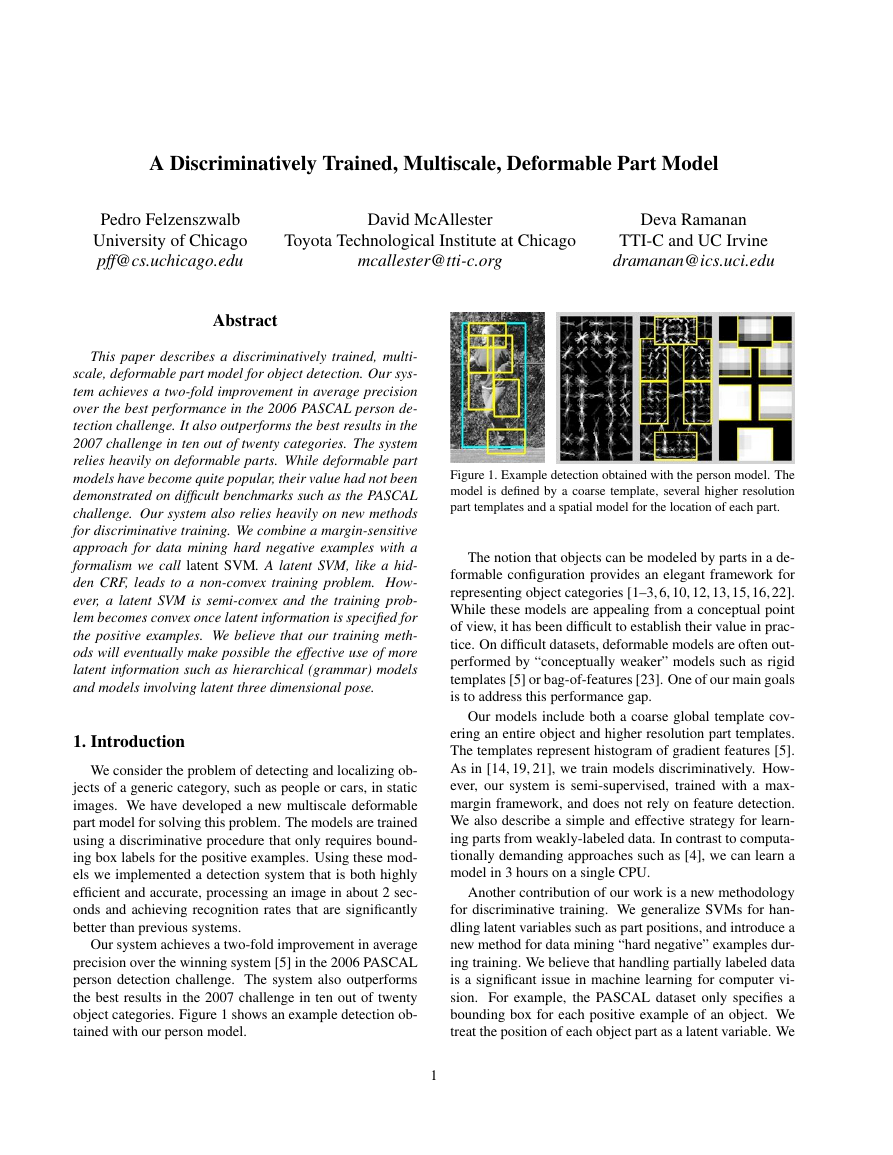
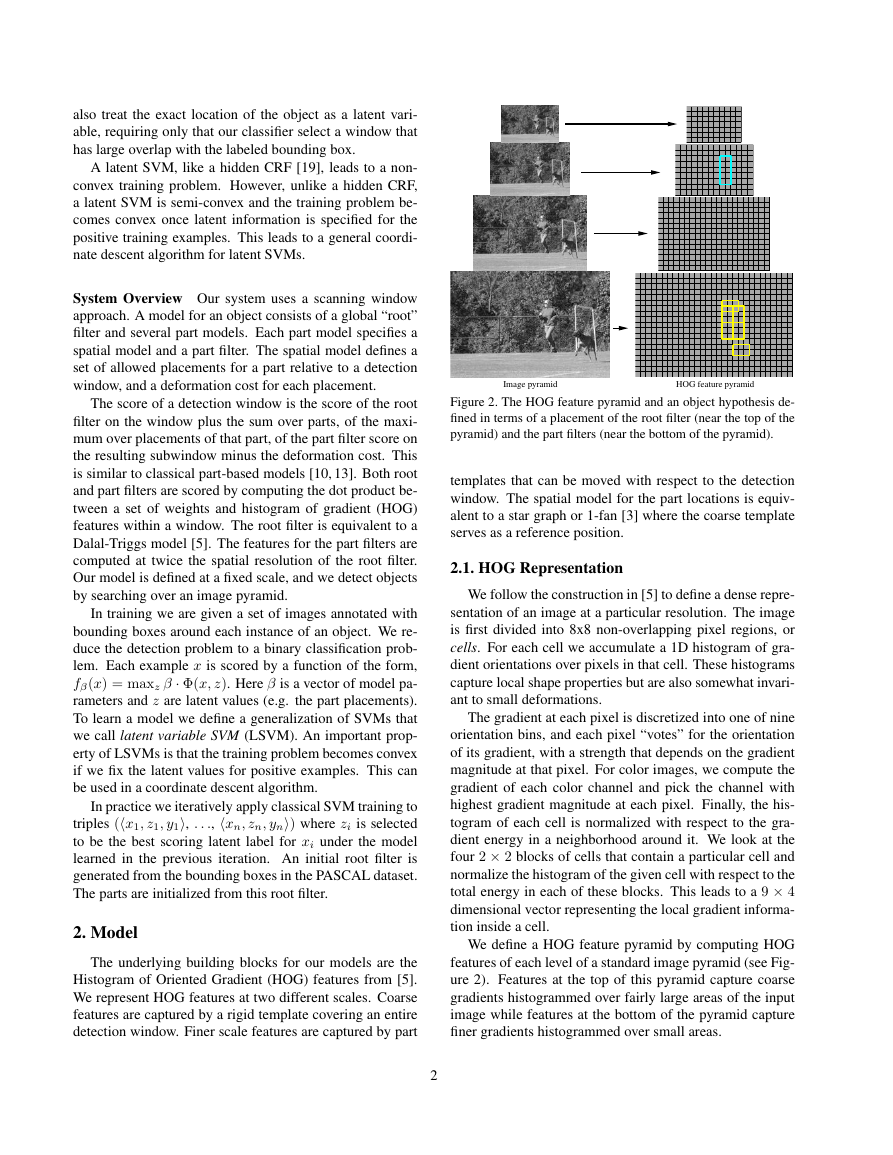
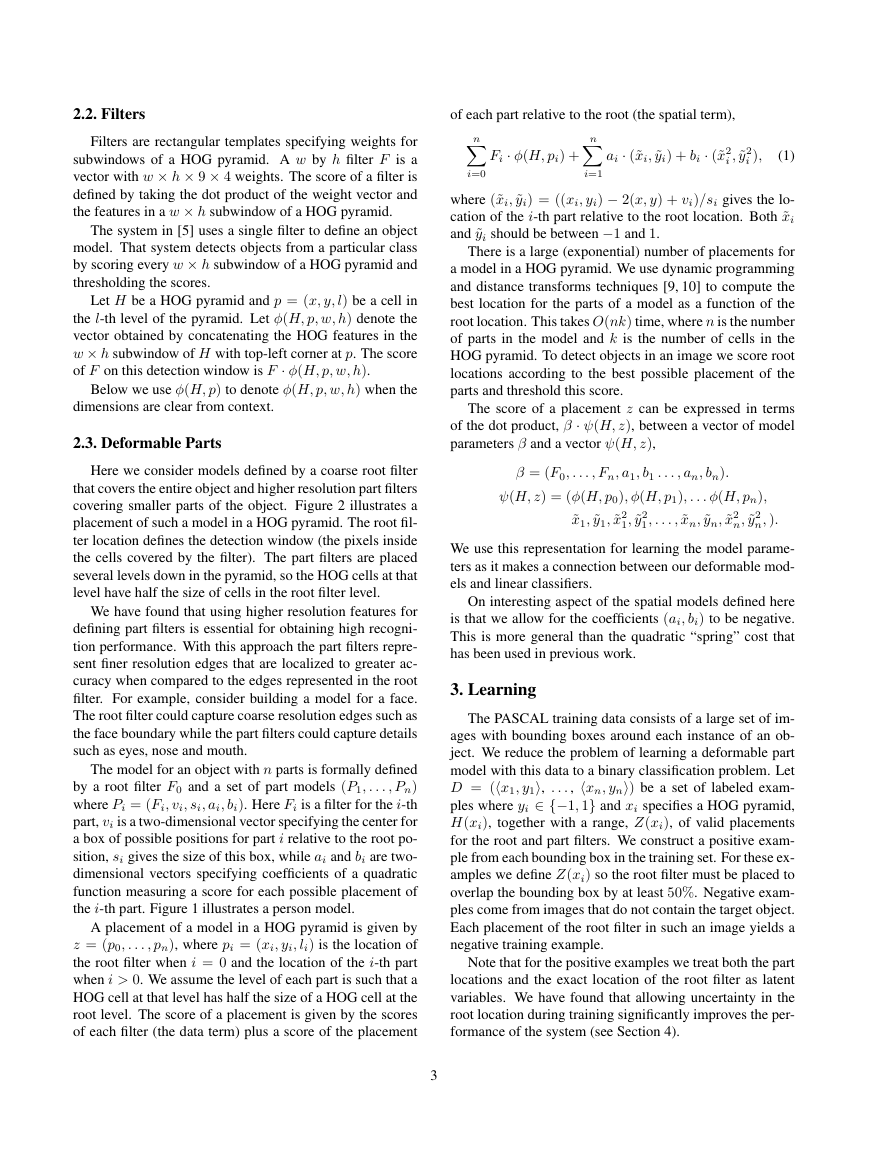

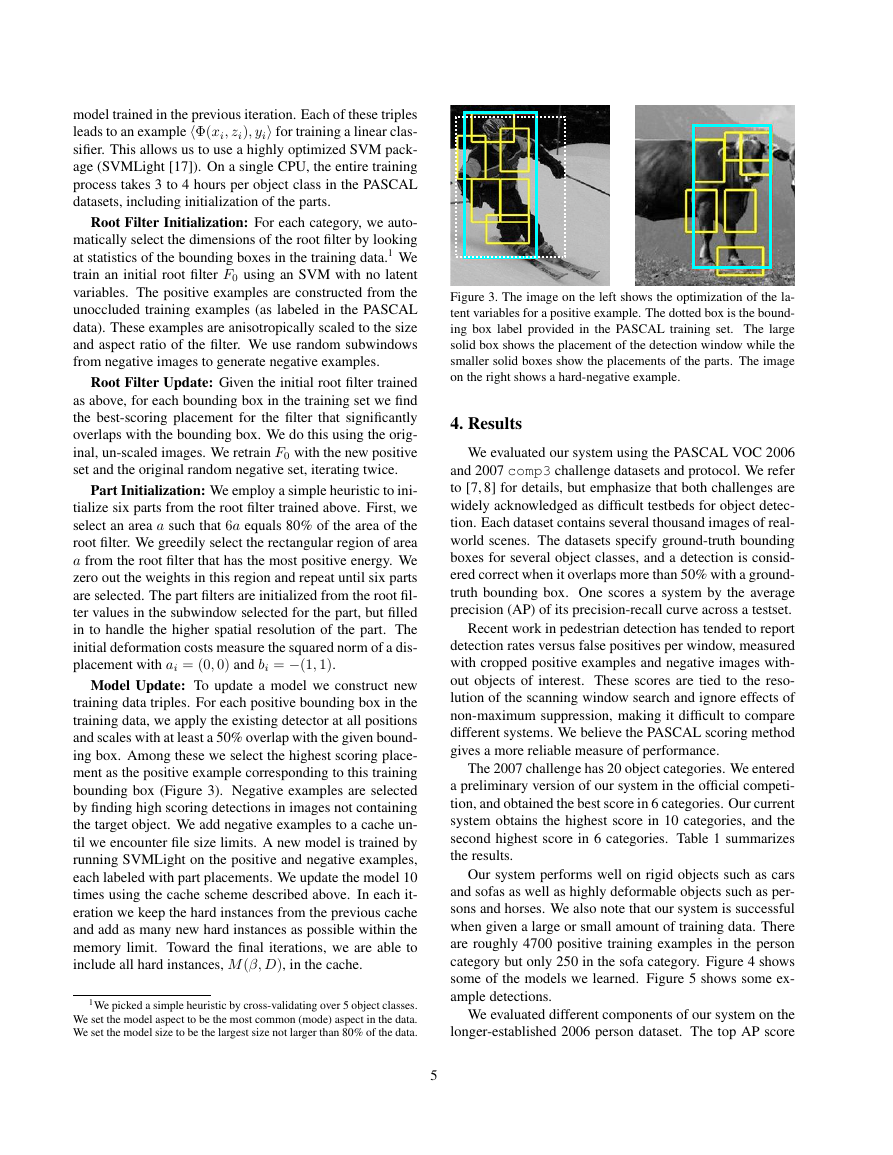
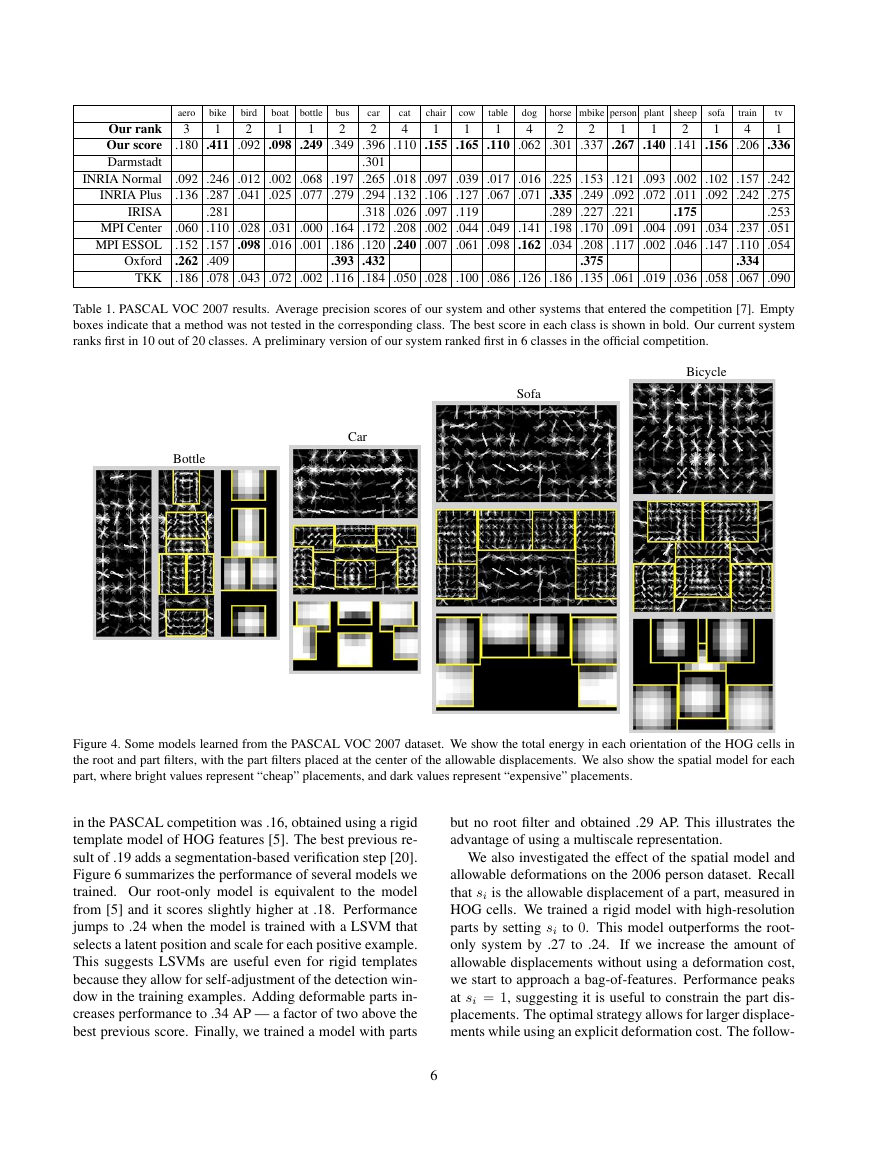
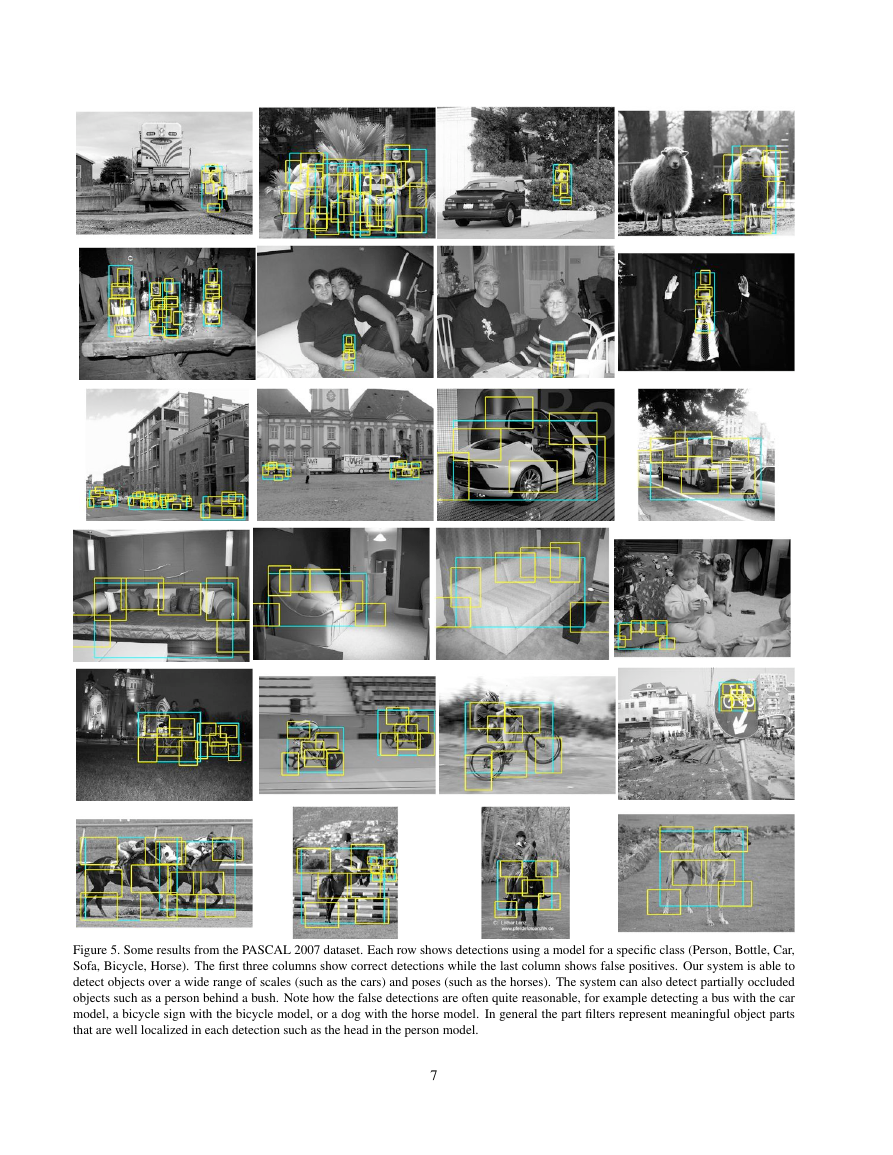
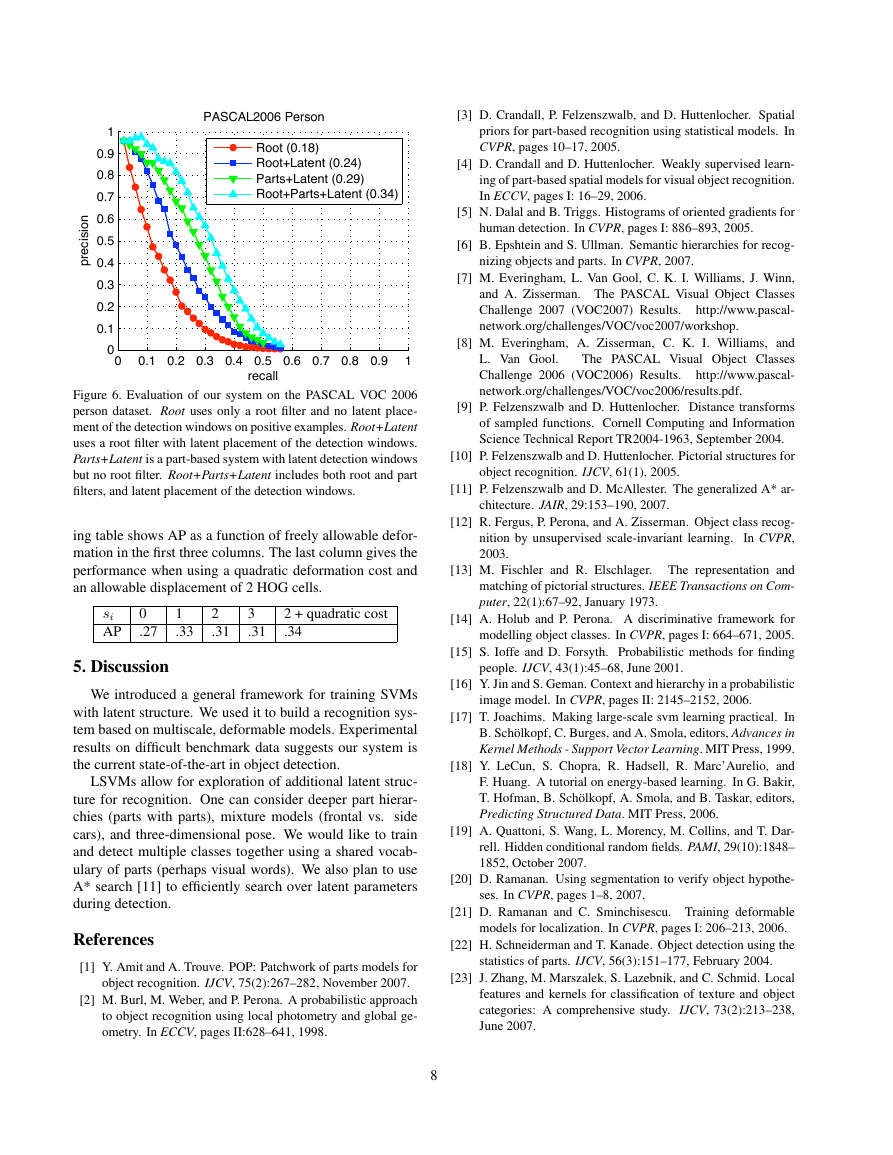








 2023年江西萍乡中考道德与法治真题及答案.doc
2023年江西萍乡中考道德与法治真题及答案.doc 2012年重庆南川中考生物真题及答案.doc
2012年重庆南川中考生物真题及答案.doc 2013年江西师范大学地理学综合及文艺理论基础考研真题.doc
2013年江西师范大学地理学综合及文艺理论基础考研真题.doc 2020年四川甘孜小升初语文真题及答案I卷.doc
2020年四川甘孜小升初语文真题及答案I卷.doc 2020年注册岩土工程师专业基础考试真题及答案.doc
2020年注册岩土工程师专业基础考试真题及答案.doc 2023-2024学年福建省厦门市九年级上学期数学月考试题及答案.doc
2023-2024学年福建省厦门市九年级上学期数学月考试题及答案.doc 2021-2022学年辽宁省沈阳市大东区九年级上学期语文期末试题及答案.doc
2021-2022学年辽宁省沈阳市大东区九年级上学期语文期末试题及答案.doc 2022-2023学年北京东城区初三第一学期物理期末试卷及答案.doc
2022-2023学年北京东城区初三第一学期物理期末试卷及答案.doc 2018上半年江西教师资格初中地理学科知识与教学能力真题及答案.doc
2018上半年江西教师资格初中地理学科知识与教学能力真题及答案.doc 2012年河北国家公务员申论考试真题及答案-省级.doc
2012年河北国家公务员申论考试真题及答案-省级.doc 2020-2021学年江苏省扬州市江都区邵樊片九年级上学期数学第一次质量检测试题及答案.doc
2020-2021学年江苏省扬州市江都区邵樊片九年级上学期数学第一次质量检测试题及答案.doc 2022下半年黑龙江教师资格证中学综合素质真题及答案.doc
2022下半年黑龙江教师资格证中学综合素质真题及答案.doc